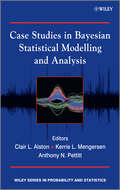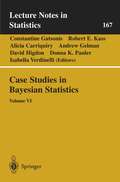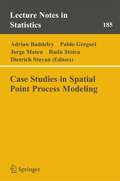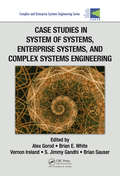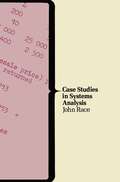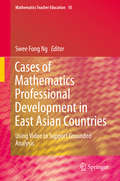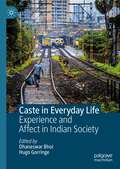- Table View
- List View
Case Studies in Bayesian Statistical Modelling and Analysis (Wiley Series in Probability and Statistics)
by Clair L. Alston Kerrie L. Mengersen Anthony N. PettittProvides an accessible foundation to Bayesian analysis using real world models This book aims to present an introduction to Bayesian modelling and computation, by considering real case studies drawn from diverse fields spanning ecology, health, genetics and finance. Each chapter comprises a description of the problem, the corresponding model, the computational method, results and inferences as well as the issues that arise in the implementation of these approaches. Case Studies in Bayesian Statistical Modelling and Analysis: Illustrates how to do Bayesian analysis in a clear and concise manner using real-world problems. Each chapter focuses on a real-world problem and describes the way in which the problem may be analysed using Bayesian methods. Features approaches that can be used in a wide area of application, such as, health, the environment, genetics, information science, medicine, biology, industry and remote sensing. Case Studies in Bayesian Statistical Modelling and Analysis is aimed at statisticians, researchers and practitioners who have some expertise in statistical modelling and analysis, and some understanding of the basics of Bayesian statistics, but little experience in its application. Graduate students of statistics and biostatistics will also find this book beneficial.
Case Studies in Bayesian Statistics: Volume III (Lecture Notes in Statistics #121)
by Constantine Gatsonis James S. Hodges Robert E. Kass Robert E. McCulloch Peter Rossi Nozer D. SingpurwallaThis third volume of case studies presents detailed applications of Bayesian statistical analysis, emphasising the scientific context. The papers were presented and discussed at a workshop held at Carnegie-Mellon University, and this volume - dedicated to the memory of Morrie Groot-reproduces six invited papers, each with accompanying invited discussion, and nine contributed papers with the focus on econometric applications.
Case Studies in Bayesian Statistics (Lecture Notes in Statistics #83)
by Constantine Gatsonis James S. Hodges Robert E. Kass Nozer D. SingpurwallaThe past few years have witnessed dramatic advances in computational methods for Bayesian inference. As a result, Bayesian approaches to solving a wide variety of problems in data analysis and decision-making have become feasible, and there is currently a growth spurt in the application of Bayesian methods. The purpose of this volume is to present several detailed examples of applications of Bayesian thinking, with an emphasis on the scientific or technological context of the problem being solved. The papers collected here were presented and discussed at a Workshop held at Carnegie-Mellon University, September 29 through October 1, 1991. There are five ma jor articles, each with two discussion pieces and a reply. These articles were invited by us following a public solicitation of abstracts. The problems they address are diverse, but all bear on policy decision-making. Though not part of our original design for the Workshop, that commonality of theme does emphasize the usefulness of Bayesian meth ods in this arena. Along with the invited papers were several additional commentaries of a general nature; the first comment was invited and the remainder grew out of the discussion at the Workshop. In addition there are nine contributed papers, selected from the thirty-four presented at the Workshop, on a variety of applications. This collection of case studies illustrates the ways in which Bayesian methods are being incorporated into statistical practice. The strengths (and limitations) of the approach become apparent through the examples.
Case Studies in Bayesian Statistics: Volume IV (Lecture Notes in Statistics #140)
by Constantine Gatsonis Robert E. Kass Bradley Carlin Alicia Carriquiry A. Gelman Isabella Verdinelli Mike WestThe 4th Workshop on Case Studies in Bayesian Statistics was held at the Car negie Mellon University campus on September 27-28, 1997. As in the past, the workshop featured both invited and contributed case studies. The former were presented and discussed in detail while the latter were presented in poster format. This volume contains the four invited case studies with the accompanying discus sion as well as nine contributed papers selected by a refereeing process. While most of the case studies in the volume come from biomedical research the reader will also find studies in environmental science and marketing research. INVITED PAPERS In Modeling Customer Survey Data, Linda A. Clark, William S. Cleveland, Lorraine Denby, and Chuanhai LiD use hierarchical modeling with time series components in for customer value analysis (CVA) data from Lucent Technologies. The data were derived from surveys of customers of the company and its competi tors, designed to assess relative performance on a spectrum of issues including product and service quality and pricing. The model provides a full description of the CVA data, with random location and scale effects for survey respondents and longitudinal company effects for each attribute. In addition to assessing the performance of specific companies, the model allows the empirical exploration of the conceptual basis of consumer value analysis. The authors place special em phasis on graphical displays for this complex, multivariate set of data and include a wealth of such plots in the paper.
Case Studies in Bayesian Statistics: Volume V (Lecture Notes in Statistics #162)
by Constantine Gatsonis Robert E. Kass Bradley Carlin Alicia Carriquiry Andrew Gelman Isabella Verdinelli Mike WestThe 5th Workshop on Case Studies in Bayesian Statistics was held at the Carnegie Mellon University campus on September 24-25, 1999. As in the past, the workshop featured both invited and contributed case studies. The former were presented and discussed in detail while the latter were presented in poster format. This volume contains the three invited case studies with the accompanying discussion as well as ten contributed pa pers selected by a refereeing process. The majority of case studies in the volume come from biomedical research. However, the reader will also find studies in education and public policy, environmental pollution, agricul ture, and robotics. INVITED PAPERS The three invited cases studies at the workshop discuss problems in ed ucational policy, clinical trials design, and environmental epidemiology, respectively. 1. In School Choice in NY City: A Bayesian Analysis ofan Imperfect Randomized Experiment J. Barnard, C. Frangakis, J. Hill, and D. Rubin report on the analysis of the data from a randomized study conducted to evaluate the New YorkSchool Choice Scholarship Pro gram. The focus ofthe paper is on Bayesian methods for addressing the analytic challenges posed by extensive non-compliance among study participants and substantial levels of missing data. 2. In Adaptive Bayesian Designs for Dose-Ranging Drug Trials D. Berry, P. Mueller, A. Grieve, M. Smith, T. Parke, R. Blazek, N.
Case Studies in Bayesian Statistics: Volume VI (Lecture Notes in Statistics #167)
This volume contains invited case studies with the accompanying discussion as well as contributed papers selected by a refereeing process of 6th Workshop on Case Studies in Bayesian Statistics was held at the Carnegie Mellon University in October, 2001.
Case Studies in Bayesian Statistics, Volume II (Lecture Notes in Statistics #105)
by Constantine Gatsonis James S. Hodges Robert E. Kaas Nozer D. SingpurwallaLike its predecessor, this second volume presents detailed applications of Bayesian statistical analysis, each of which emphasizes the scientific context of the problems it attempts to solve. The emphasis of this volume is on biomedical applications. These papers were presented at a workshop at Carnegie-Mellon University in 1993.
Case Studies in Data Analysis (Lecture Notes in Statistics #94)
by Jane F. Gentleman G. A. WhitmoreThis volume is a collection of eight Case Studies in Data Analysis that appeared in various issues of the Canadian Journal of Statistics (OS) over a twelve year period from 1982 to 1993. One follow-up article to Case Study No.4 is also included in the volume. The OS's Section on Case Studies in Data Analysis was initiated by a former editor who wanted to increase the analytical content of the journal. We were asked to become Section Co-Editors and to develop a format for the case studies. Each case study presents analyses of a real data set by two or more analysts or teams of analysts working independently in a simulated consulting context. The section aimed at demonstrating the process of statistical analysis and the possible diversity of approaches and conclusions. For each case study, the Co-Editors found a set of real Canadian data, posed what they thought was an interesting statistical problem, and recruited analysts working in Canada who were willing to tackle it. The published case studies describe the data and the problem, and present and discuss the analysts' solutions. For some case studies, the providers of the data were invited to contribute their own analysis.
Case Studies in Environmental Statistics (Lecture Notes in Statistics #132)
by Douglas Nychka Walter W. Piegorsch Lawrence H. CoxThis book offers a set of case studies exemplifying the broad range of statis tical science used in environmental studies and application. The case studies can be used for graduate courses in environmental statistics, as a resource for courses in statistics using genuine examples to illustrate statistical methodol ogy and theory, and for courses in environmental science. Not only are these studies valuable for teaching about an essential cross-disciplinary activity but they can also be used to spur new research along directions exposed in these examples. The studies reported here resulted from a program of research carried on by the National Institute of Statistical Sciences (NISS) during the years 1992- 1996. NISS was created in 1991 as an initiative of the national statistics or ganizations, with the mission to renew and focus efforts of statistical science on important cross-disciplinary problems. One of NISS' first projects was a cooperative research effort with the U.S. Environmental Protection Agency (EPA) on problems of great interest to environmental science and regulation, surely one of today's most important cross-disciplinary activities. With the support and encouragement of Gary Foley, Director of the (then) U.S. EPA Atmospheric Research and Exposure Assessment Laboratory, a project and a research team were assembled by NISS that pursued a program which produced a set of results and products from which this book was drawn.
Case Studies in Reliability and Maintenance (Wiley Series in Probability and Statistics #480)
by Wallace R. Blischke D. N. Prabhakar MurthyIntroducing a groundbreaking companion book to a bestselling reliability text Reliability is one of the most important characteristics defining the quality of a product or system, both for the manufacturer and the purchaser. One achieves high reliability through careful monitoring of design, materials and other input, production, quality assurance efforts, ongoing maintenance, and a variety of related decisions and activities. All of these factors must be considered in determining the costs of production, purchase, and ownership of a product. Case Studies in Reliability and Maintenance serves as a valuable addition to the current literature on the subject of reliability by bridging the gap between theory and application. Conceived during the preparation of the editors' earlier work, Reliability: Modeling, Prediction, and Optimization (Wiley, 2000), this new volume features twenty-six actual case studies written by top experts in their fields, each illustrating exactly how reliability models are applied. A valuable companion book to Reliability: Modeling, Prediction, and Optimization, or any other textbook on the subject, the book features: * Case studies from fields such as aerospace, automotive, mining, electronics, power plants, dikes, computer software, weapons, photocopiers, industrial furnaces, granite building cladding, chemistry, and aircraft engines * A logical organization according to the life cycle of a product or system * A unified format of discussion enhanced by tools, techniques, and models for drawing one's own conclusions * Pertinent exercises for reinforcement of ideas Of equal value to both students of reliability theory as well as professionals in industry, Case Studies in Reliability and Maintenance should be required reading for anyone seeking to understand how reliability and maintenance issues can be addressed and resolved in the real world.
Case Studies in Spatial Point Process Modeling (Lecture Notes in Statistics #185)
by Adrian Baddeley Pablo Gregori Jorge Mateu Mahiques Radu Stoica Dietrich StoyanPoint process statistics is successfully used in fields such as material science, human epidemiology, social sciences, animal epidemiology, biology, and seismology. Its further application depends greatly on good software and instructive case studies that show the way to successful work. This book satisfies this need by a presentation of the spatstat package and many statistical examples. Researchers, spatial statisticians and scientists from biology, geosciences, materials sciences and other fields will use this book as a helpful guide to the application of point process statistics. No other book presents so many well-founded point process case studies. From the reviews: "For those interested in analyzing their spatial data, the wide variatey of examples and approaches here give a good idea of the possibilities and suggest reasonable paths to explore." Michael Sherman for the Journal of the American Statistical Association, December 2006
Case Studies in System of Systems, Enterprise Systems, and Complex Systems Engineering
by Alex Gorod Brian E. White Vernon Ireland S. Jimmy Gandhi Brian SauserSuitable as a reference for industry practitioners and as a textbook for classroom use, Case Studies in System of Systems, Enterprise Systems, and Complex Systems Engineering provides a clear understanding of the principles and practice of system of systems engineering (SoSE), enterprise systems engineering (ESE), and complex systems engineering (C
Cases of Assessment in Mathematics Education: An ICMI Study (New ICMI Study Series #1)
by Mogens NissThe present book, Cases of Assessment in Mathematics Education, is one of two studies resulting from an ICMI Study Conference on Assessment in Mathematics Education and Its Effects. The book which is published in the series of ICMI Studies under the general editorship of the President and Secretary of ICMI is closely related to another study resulting from the same conference: Investigations into Assessment in Mathematics Education (Niss, 1992). The two books, although originating from the same sources and having the same editor, emphasize different aspects of assessment in mathematics education and can be read independently of one another. While the present book is devoted to presenting and discussing cases of assessment that are actually implemented, the other study attempts to critically analyze general and principal aspects of assessment. Naturally, the content of either book is enriched by the materials and perspectives provided by the other one. In order to put this book and its background into context, the nature and scope of the ICMI studies are outlined briefly below.
Cases of Mathematics Professional Development in East Asian Countries: Using Video to Support Grounded Analysis (Mathematics Teacher Education #10)
by Swee Fong NgThis book shows how video technology can be used to inform teachers’ personal practice, and provides new data and real-world case studies not covered by any previous book on the subject.Initial chapters explore how practicing teachers can view their own recorded lessons and take steps to improve their methods, while subsequent chapters examine how pre-service and in-service teachers can use recorded lessons to improve how they teach selected concepts, or to better convey specific learning processes such as mathematical modeling and problem solving.
Cassandra non era un'idiota: Il destino è prevedibile (I blu)
by Renato Di LorenzoEsiste una cosa chiamata destino? o è solo un mito, come quello di Cassandra?Si fa sempre un po’ fatica – ovvio – a pensare che il mito (nella fattispecie quello di Cassandra) racconti fatti realmente accaduti. Infatti non sono realmente accaduti. Ma è difficile che il mito racconti fatti totalmente impossibili. Nessuno sa perché, ma il mito verte sempre intorno ad accadimenti che un giorno magari si riveleranno un po’ veri. Non del tutto veri: solo un po’. Ma veri.E’ così del resto anche per molte verità scientifiche, presagite nel passato, e verificate in seguito usando la fisica e le altre scienze che, sviluppate, sono poi state capaci di affrontarle.Ma esiste allora una matematica del destino, qualcosa come il principio di minima azione di Hamilton, che date le condizioni iniziali di un mondo macroscopico determina in maniera univoca lo stato futuro del mondo stesso? Per quanto increduli, la risposta deve essere: sì.
Cassirer (The Routledge Philosophers)
by Samantha MatherneErnst Cassirer (1874–1945) occupies a unique place in 20th-century philosophy. His view that human beings are not rational but symbolic animals and his famous dispute with Martin Heidegger at Davos in 1929 are compelling alternatives to the deadlock between 'analytic' and 'continental' approaches to philosophy. An astonishing polymath, Cassirer's work pays equal attention to mathematics and natural science but also art, language, myth, religion, technology, and history. However, until now the importance of his work has largely been overlooked. In this outstanding introduction Samantha Matherne examines and assesses the full span of Cassirer’s work. Beginning with an overview of his life and works she covers the following important topics: Cassirer’s neo-Kantian background Philosophy of mathematics and natural science, including Cassirer’s first systematic work, Substance and Function, and subsequent works, like Einstein’s Theory of Relativity The problem of culture and the ground-breaking The Philosophy of Symbolic Forms Cassirer’s ethical and political thought and his diagnosis of fascism in The Myth of the State Cassirer’s influence and legacy. Including chapter summaries, suggestions for further reading, and a glossary of terms, this is an ideal introduction to Cassirer’s thought for anyone coming to his work for the first time. It is essential reading for students in philosophy as well as related disciplines such as intellectual history, art history, politics, and literature.
Cassirer (The Routledge Philosophers)
by Samantha MatherneErnst Cassirer (1874–1945) occupies a unique place in 20th-century philosophy. His view that human beings are not rational but symbolic animals and his famous dispute with Martin Heidegger at Davos in 1929 are compelling alternatives to the deadlock between 'analytic' and 'continental' approaches to philosophy. An astonishing polymath, Cassirer's work pays equal attention to mathematics and natural science but also art, language, myth, religion, technology, and history. However, until now the importance of his work has largely been overlooked. In this outstanding introduction Samantha Matherne examines and assesses the full span of Cassirer’s work. Beginning with an overview of his life and works she covers the following important topics: Cassirer’s neo-Kantian background Philosophy of mathematics and natural science, including Cassirer’s first systematic work, Substance and Function, and subsequent works, like Einstein’s Theory of Relativity The problem of culture and the ground-breaking The Philosophy of Symbolic Forms Cassirer’s ethical and political thought and his diagnosis of fascism in The Myth of the State Cassirer’s influence and legacy. Including chapter summaries, suggestions for further reading, and a glossary of terms, this is an ideal introduction to Cassirer’s thought for anyone coming to his work for the first time. It is essential reading for students in philosophy as well as related disciplines such as intellectual history, art history, politics, and literature.
Casson's Invariant for Oriented Homology Three-Spheres: An Exposition. (MN-36) (PDF)
by Selman Akbulut John D. MccarthyIn the spring of 1985, A. Casson announced an interesting invariant of homology 3-spheres via constructions on representation spaces. This invariant generalizes the Rohlin invariant and gives surprising corollaries in low-dimensional topology. In the fall of that same year, Selman Akbulut and John McCarthy held a seminar on this invariant. These notes grew out of that seminar. The authors have tried to remain close to Casson's original outline and proceed by giving needed details, including an exposition of Newstead's results. They have often chosen classical concrete approaches over general methods. For example, they did not attempt to give gauge theory explanations for the results of Newstead; instead they followed his original techniques.Originally published in 1990.The Princeton Legacy Library uses the latest print-on-demand technology to again make available previously out-of-print books from the distinguished backlist of Princeton University Press. These editions preserve the original texts of these important books while presenting them in durable paperback and hardcover editions. The goal of the Princeton Legacy Library is to vastly increase access to the rich scholarly heritage found in the thousands of books published by Princeton University Press since its founding in 1905.
Caste in Everyday Life: Experience and Affect in Indian Society
by Dhaneswar Bhoi Hugo GorringeThis edited volume brings together a range of scholars to reflect on the varied ways in which caste is manifested and experienced in social life. Each chapter draws on different methods and approaches but all consider lived experiences and experiential narrations. Considering Guru and Sarukkai’s path-breaking work on ‘Experience, Caste and the Everyday Social’ (2019), this volume applies the insights of the theories to multiple settings, issues and communities. Unique to this volume, Brahmin and other dominant castes' experiences are considered, rather than simply focusing on the lives of oppressed castes (Dalits). Analysis of cross-caste friendships or romances and marriages, furthermore, brings out the intimate and ingrained aspects of caste. Taken together, therefore, the contributions in this volume offer rich insights into caste and its consciousness within the framework of everyday experiences.
CAT: An Introduction (Lecture Notes in Mathematics #2324)
by Petra SchwerIn recent years cube complexes have become a cornerstone topic of geometric group theory and have proven to be a powerful tool in other areas, such as low dimensional topology, phylogenetic trees or in the context of optimization problems.This book covers a wide variety of algebraic and geometric properties of cube complexes and the groups acting on them. The content ranges from basic properties of metric spaces, notions of non-positive curvature, Gromov's link condition and the Švarc–Milnor theorem to advanced material such as the cubulation of half-space systems and the Roller boundary, the construction of cube complexes associated with Coxeter groups, and the Tits alternative for cubical groups.Being the first self-contained, comprehensive introduction to cube complexes this book serves as an entry point for researchers interested in the subject. The material is accessible to advanced undergraduate and graduate students. The text is illustrated with many figures and examples and comes with a large collection of exercises.
Cataclysmic Variables: Proceedings of the Conference held in Abano Terme, Italy, 20–24 June 1994 (Astrophysics and Space Science Library #205)
by A. Bianchini M. Della Valle M. OrioCataclysmic Variables (CVs) are well furnished laboratories in which one can investigate a number of important physical processes. These processes include: thermonuclear reactions, nebular physics, winds, mass accretion phenomena on compact objects, magnetohydrodynamics, plasmas, thermal and non thermal radiative processes, relativistic phenomena, dust forma tion, etc . . In the recent year the most exciting development in our opinion was that the small, cold and invisible secondary components of CV s were found to be the prime motors for the evolution of close binary systems, disclosing new scenarios for research. All branches of astronomy and as trophysics often take advantage of the new ideas brought by the study of CVs. It is for this reason, we believe, that meetings on CVs are important for most of the astronomical community. The idea of a Congress on CVs in Padova has been fluttering in the air for a few years. After all - we thought - a large part of the scientific heritage of Padova and Asiago Observatories is represented by the study of variable stars and, in particular, of CV s, as Prof. L. Rosino reminded us at the very beginning of the Congress. We finally chose Abano Terme as the site of the Conference, not merely because Abano is one of the most famous centers in Europe for mud therapy, and astronomers easily suffer from rheumatism, but also because we knew that a very hearty welcome from the Abano Municipality and touristic associations awaited us.
Catalan Numbers with Applications
by Thomas KoshyLike the intriguing Fibonacci and Lucas numbers, Catalan numbers are also ubiquitous. "They have the same delightful propensity for popping up unexpectedly, particularly in combinatorial problems," Martin Gardner wrote in Scientific American. "Indeed, the Catalan sequence is probably the most frequently encountered sequence that is still obscure enough to cause mathematicians lacking access to Sloane's Handbook of Integer Sequences to expend inordinate amounts of energy re-discovering formulas that were worked out long ago," he continued. As Gardner noted, many mathematicians may know the abc's of Catalan sequence, but not many are familiar with the myriad of their unexpected occurrences, applications, and properties; they crop up in chess boards, computer programming, and even train tracks. This book presents a clear and comprehensive introduction to one of the truly fascinating topics in mathematics. Catalan numbers are named after the Belgian mathematician Eugene Charles Catalan (1814-1894), who "discovered" them in 1838, though he was not the first person to discover them. The great Swiss mathematician Leonhard Euler (1707-1763) "discovered" them around 1756, but even before then and though his work was not known to the outside world, Chinese mathematician Antu Ming (1692?-1763) first discovered Catalan numbers about 1730. Catalan numbers can be used by teachers and professors to generate excitement among students for exploration and intellectual curiosity and to sharpen a variety of mathematical skills and tools, such as pattern recognition, conjecturing, proof-techniques, and problem-solving techniques. This book is not only intended for mathematicians but for a much larger audience, including high school students, math and science teachers, computer scientists, and those amateurs with a modicum of mathematical curiosity. An invaluable resource book, it contains an intriguing array of applications to computer science, abstract algebra, combinatorics, geometry, graph theory, chess, and World Series.
Catalan's Conjecture (Universitext)
by René SchoofEugène Charles Catalan made his famous conjecture – that 8 and 9 are the only two consecutive perfect powers of natural numbers – in 1844 in a letter to the editor of Crelle’s mathematical journal. One hundred and fifty-eight years later, Preda Mihailescu proved it. Catalan’s Conjecture presents this spectacular result in a way that is accessible to the advanced undergraduate. The author dissects both Mihailescu’s proof and the earlier work it made use of, taking great care to select streamlined and transparent versions of the arguments and to keep the text self-contained. Only in the proof of Thaine’s theorem is a little class field theory used; it is hoped that this application will motivate the interested reader to study the theory further. Beautifully clear and concise, this book will appeal not only to specialists in number theory but to anyone interested in seeing the application of the ideas of algebraic number theory to a famous mathematical problem.
Catastrophe Theory
by V. I. Arnol'dSingularity theory is growing very fast and many new results have been discovered since the Russian edition appeared: for instance the relation of the icosahedron to the problem of by passing a generic obstacle. The reader can find more details about this in the articles "Singularities of ray systems" and "Singularities in the calculus of variations" listed in the bi bliography of the present edition. Moscow, September 1983 v. I. Arnold Preface to the Russian Edition "Experts discuss forecasting disasters" said a New York Times report on catastrophe theory in November 1977. The London Times declared Catastrophe Theory to be the "main intellectual movement of the century" while an article on catastrophe theory in Science was headed "The emperor has no clothes". This booklet explains what catastrophe theory is about and why it arouses such controversy. It also contains non-con troversial results from the mathematical theories of singulari ties and bifurcation. The author has tried to explain the essence of the fundamen tal results and applications to readers having minimal mathe matical background but the reader is assumed to have an in quiring mind. Moscow 1981 v. I. Arnold Contents Chapter 1. Singularities, Bifurcations, and Catastrophe Theories ............... 1 Chapter 2. Whitney's Singularity Theory ... 3 Chapter 3. Applications of Whitney's Theory 7 Chapter 4. A Catastrophe Machine ...... 10 Chapter 5. Bifurcations of Equilibrium States 14 Chapter 6. Loss of Stability of Equilibrium and the Generation of Auto-Oscillations . . . . . . 20 .
